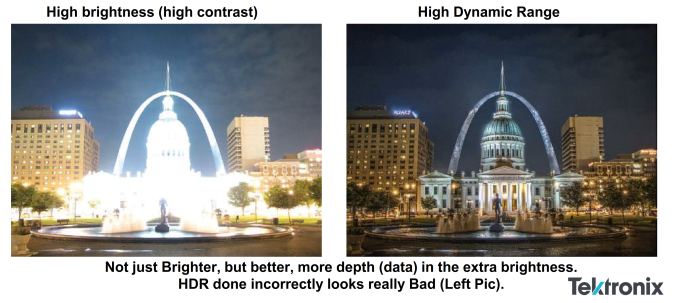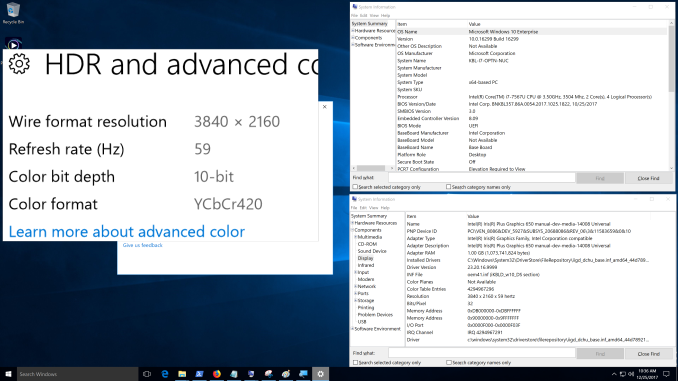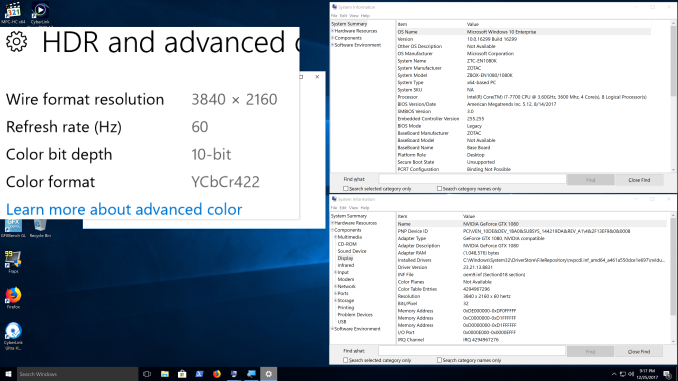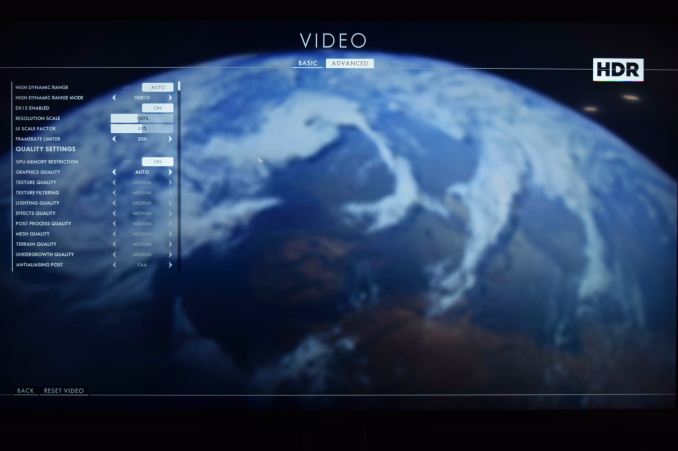A Budget Home Theater & PC Setup: 4K, HDR, UHD Blu-ray, and More
by Ganesh T S on December 26, 2017 8:30 AM ESTHDR Support
High Dynamic Range (HDR) is one of the most impressive features in the recent crop of 4K televisions. In layman's terms, it refers to the ability of a single frame to have wide variation in brightness for different regions. This allows the details in the dimly lit areas of the frame to be seen more clearly. Overall, it delivers a more vivid picture to the viewer. Note that this is quite different from the concept of high contrast.
Picture courtesy: SMPTE HDR Presentation from Steven Holmes of Tektronix
The ability of a display source to transmit HDR frames, as well as that of a display sink to be able to accept and understand them, can be gathered from the HDMI port's specifications. However, being able to accept and understand is only part of the problem. There are many low-cost 'fake HDR' TVs that simply parse the HDR information, but, do not have the ability to translate that to the display.
There are many HDR 'standards', with the base requirement being HDR10. Shifting a display sink into HDR mode involves the source sending some information (metadata) with the characteristics of the video being transported (the mapping of the pixel data to the displayed luminance, light levels in the video stream etc.). If this is static (i.e, done once when the shift to HDR mode occurs), it falls under the HDR10 category. Dolby Vision allows for the metadata to change on a frame-by-frame basis (dynamic). The upcoming HDR10+ standard will also support dynamic metadata. The takeaway is that Dolby Vision certification all but ensures a display with true HDR capabilities.
The TCL 55P607 comes with standard HDR10 and Dolby Vision support. The native Roku apps shift to the appropriate HDR mode based on the content being played back. We will analyze this more in the subsequent sections.
The NVIDIA SHIELD Android TV (SATV) is similar to the native Roku app in the TV with respect to treatment of HDR content. The main issue is that SATV doesn't support Dolby Vision yet, though there is a lot of clamor for it from SATV owners. Videos with HDR10 metadata shift the display to the appropriate HDR mode prior to playback.
PCs encounter additional challenges for HDR implementation. It is just not one company that is responsible for the feature. On one hand, the GPU driver vendors need to support it. On the other hand, the OS itself needs to provide hooks to enable HDR. Finally, the software ecosystem needs to catch up. The Windows 10 Fall Creators Update brought HDR10 capabilities for the Windows desktop into the stable ring. It also allowed streaming of HDR videos from YouTube and Netflix. Microsoft is continuing to fine-tune the HDR capabilities built into Windows 10.
Intel, along with CyberLink, had decided not to wait for Microsoft to deliver HDR on PCs. PowerDVD 17 was the first software Blu-ray player, and it only made sense for them to support HDR playback for applicable titles. The Intel / CyberLink solution for HDR when playing back certain Blu-rays in full-screen exclusive mode is orthogonal to Microsoft's HDR support.
The Windows 10 Fall Creators Update enabled desktop HDR and HDR video streaming on all the three test PCs described earlier.
HDR and Advanced Color Settings - Intel NUC7i7BNHX1 with Desktop HDR Enabled
The KBL-U platforms drove the display at YCbCr 4:2:0 10-bit, while the NVIDIA GTX 1080 drove the HDR output with higher quality (YCbCr 4:2:2 10-bit). For a good desktop experience, 4:4:4 is preferable.
HDR and Advanced Color Settings - Zotac ZBOX MAGNUS EN1080K with Desktop HDR Enabled
Gaming is not a focus in our HTPC reviews, but, we must give credit to NVIDIA for supporting Dolby Vision in their Pascal GPUs. Certain gaming titles such as Battlefield 1 support both HDR varieties (HDR10 and Dolby Vision), and the Zotac EN1080K is able to deliver it in a HTPC environment, thanks to its small form factor and relatively silent liquid cooling.
Battlefield 1 HDR Output from the Zotac EN1080K
Battlefield 1 Dolby Vision Output from the Zotac EN1080K
Unfortunately, Pascal's Dolby Vision support is available only in certain games, and is not applicable to streaming services like Netflix.
Microsoft's current approach to HDR with a desktop HDR mode is currently not efficiently implemented. For example, the desktop in the Zotac ZBOX MAGNUS EN1080K idles at 34.5W. With the HDR mode enabled, this jumps to 39.5W. In the KBL-U systems the penalty is of the order of 0.8W - 1W.















191 Comments
View All Comments
Alreyouano - Monday, January 1, 2018 - link
Sir, good day, im new in the home theater field. May i know what kind of speakers and how many do i need to buy to set up a 7.1.2 home theater at home. Thank you.Reflex - Monday, January 1, 2018 - link
Well to start the number you listed there actually tells you the total. 7.1.2 = 7 surround speakers (two front left/right, one center, one on each side, two behind), 1 subwoofer and 2 upwards firing drivers or ceiling mounted speakers for the space above the viewer.As to brands and so on you need to make certain your receiver or soundbar supports Dolby Atmos, I suggest avsforums.com for more info and user preferences.
Golgatha777 - Monday, January 1, 2018 - link
That would be 10 speakers if you include the subwoofer.5 up front (R,L,C, RP, LP), 4 in the back (RS, LS, RSB, LSB), and the subwoofer.
Reflex - Tuesday, January 2, 2018 - link
I think that's what I said? You included the RS/LS as 'back' and I listed them separately as "one on each side" in my description. One question I would have for you though: The upwards firing ones, if you only have 2 of them should they be front or back?I'm using a Samsung HW-K950 so it has four upwards firing drivers, but in a 7.1.2 you'd only have 2 presumably unless you drop the sides...
Alreyouano - Tuesday, January 2, 2018 - link
Thank you.kallek - Friday, January 5, 2018 - link
My biggest problem with HTCP's is the stutter from playing 23.976 clips. Using Reclock helps but it only works with some programs and I haven't got it to work well with DTS HD Master Audio and Dolby True HDVorl - Monday, January 15, 2018 - link
So, I haven't read all 18 pages of comments, so if this has been mentioned already, sorry.Why a 4k tv? They are a gimmick. If you sit more than a couple feet from your 55' TV, you can't see the difference. Here is a good link to explain it. https://referencehometheater.com/2013/commentary/4...
Sure, you can see the difference if you were gaming, and sitting NEXT to your monitor, but most people sit several to many feet from their TV, so even a big tv at 4k isn't something you can see. A lot of extra cost for no real gain.
mikato - Thursday, January 18, 2018 - link
Fun time reading the comments :) I’d just like to say that I came here and read it for the HTPC info. I would like to make a (better) HTPC but I won’t be upgrading my old home theater setup, so I wasn’t looking for stuff about receivers, TVs, etc. Doesn’t matter to me, but just figured I’d throw in my perspective. If I bought a new house or something, then I might be interested in that stuff. But as it is, I’ll be using what I have now for those items which work pretty darn well.iescheck2 - Wednesday, January 24, 2018 - link
It is not clear to me if the ASRock Beebox-S 7200U or Intel NUC7i7BNHX can stream Dolby True HD and DTS-HD MA through the HDMI to the AV receiver. Comparing those setups to a i5 notebook, what would be the advantages and disadvantages of each, since they may be similar in price?prateekprakash - Saturday, July 21, 2018 - link
Greetings @ganeshts .It would be great if you did a follow-up article, now that HDR & wcg mode works much better on windows 10.
I have a query: does the HDMI out of the pc go into the AVR, and the 4k60p out of the AVR goes to the TV?
I am asking this because I have my Sony x800d TV connected to my GTX 1060 HDMI out, and the windows sound icon shows only stereo and 5.1 as available options (the 7.1 option is greyed out).
Does that mean GTX 1060 HDMI out is limited to 6 channels only? Or is it somehow related to my msi b250 Mobo?
If I routed
GPU HDMI out>>AVR source in>>AVR>>AVR HDMI out>>TV
Would it then show 7.1 option?
I am new to home theatre space, and I intend to set-up my first home theatre, so I thought it would be wise to learn about it.